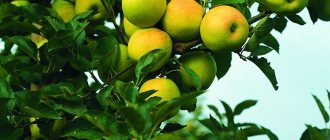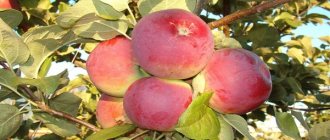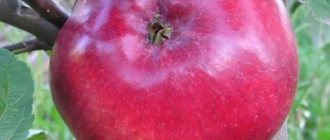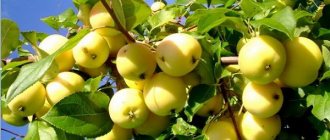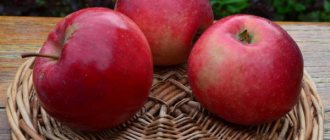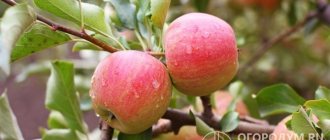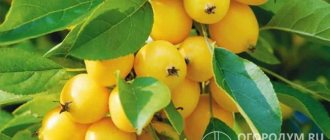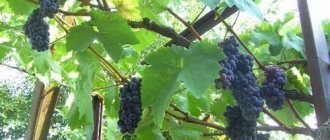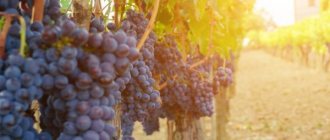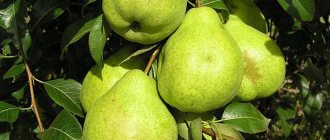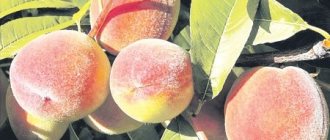The Kovalenkovskoe apple tree is the pride of many domestic summer residents. Large and incredibly sweet fruits of this variety are a real storehouse of useful vitamins and microelements. With proper care, the tree pleases gardeners with consistently high yields for many years.
The apple tree variety “Kovalenkovskoye” (pictured) is sometimes popularly called “Red Sweet”
We invite you to get to know this sweet-fruited variety more closely and, first, we present its main characteristics in the table:
| Parameter | Characteristic |
| Culture | Apple tree (Malus domestica Borkh.) |
| Variety | "Kovalenkovskoe" |
| Tree height | Medium height |
| Precociousness | High – begins to bear fruit in the 2-3rd year after planting (on weak-growing rootstocks) |
| Terms of removable (technical) maturity | Second half of August – mid-September (depending on the region) |
| Period of consumption/keeping quality of fruits | Summer-autumn - apples are stored for 1-2 months |
| Type of fruiting | Ringed |
| Productivity | Average yield 111 c/ha, maximum 160 c/ha |
| Fruit weight | 140-160 g |
| Shape and color | The fruits are one-dimensional, round-conical, smooth, regular in shape. The main color at the stage of consumer maturity is greenish, the integumentary color is dark red, blurred |
| Fruit pulp | White, medium density, prickly, juicy |
| Tasting assessment (taste qualities) | 4.8 points (out of 5) – sweet taste |
| Purpose of fruits | Universal |
| Sustainability | Winter hardiness is high, drought resistance is average; slightly affected by scab |
| Year of inclusion in the State Register of the Russian Federation | 2006 |
| Recommended growing regions | Northwestern (2) and Central (3) |
| Year of inclusion in the State Register of Belarus | 1999 |
| Recommended growing regions | Throughout the territory |
| Originator | RUE "Institute of Fruit Growing" NAS of Belarus |
Description
The Kovalenkovskoye apple tree is the result of accidental pollination of the old Lafram variety.
Kovalenkovskoe was bred by Belarusian breeders , and a new variety was named after one of them.
Sometimes called differently - Red Sweet. Registered in Belarus in 1999, in Russia in 2006.
Typical late summer variety:
- The tree grows quickly and a medium-sized trunk is formed.
- The trunk and twisted skeletal branches are covered with glossy brown bark.
- The shoots are large, red-burgundy, covered with villi.
- The crown is small , round, dense, prone to thickening.
- The leaves are elongated, oval, small in size, rich green, with crenate edges.
Flowering early . Forms inflorescences of five large white flowers.
Fruits on ringlets , less often on annual shoots:
- The apples are large , weighing from 160 to 200 grams.
- The color of the skin is light green, hidden under an abundant bright crimson blush that densely covers the entire surface.
- The fruits are covered with whitish wax.
- The fruit pulp is white, fine-grained, dense, prone to chipping.
- The aroma is weak, the taste is very sweet , without sourness.
Delicious baked goods made from Kovalenkovskoye apples.
Apples are consumed fresh and used for baking and winter preparations.
IMPORTANT! The variety has average resistance to disease and drought, and tolerates frost well. It is characterized by early fruiting and stable yield.
additional characteristics
When cultivating apple trees, you should take into account the individual characteristics of the Kovalenkovskoye variety.
Advantages and disadvantages
Gardeners highlight the following advantages of the variety :
- Precociousness;
- Regular, consistently high yields;
- Winter hardiness;
- After ripening, the fruits are firmly held on the branches .
Among the disadvantages:
- Unfriendly, time-drawn out harvest;
- Average resistance to scab and other diseases;
- Low drought resistance;
- Typical for summer varieties is a short shelf life.
Tree height
Apple tree "Kovalenkovskoe".
The tree is medium-sized and grows up to 4.5-5 meters on a seedling rootstock without pruning.
Crown width
The crown without pruning is rounded, 3-4 meters wide.
Annual growth
The apple tree grows quickly , the annual growth in favorable conditions is 0.9 - 1.1 meters.
Precociousness
The Kovalenkovskoe apple tree variety is early-fruiting; the first significant harvest of the seedling is harvested 2 or 3 years after planting.
Productivity
The Kovalenkovskoye apple tree bears fruit every year, the yield is consistently high, in industrial orchards they get 300 centners per hectare .
Productivity is consistently high.
Self-fertility
The variety is self-fertile, pollinators are not needed.
ATTENTION! Experienced gardeners believe that even self-fertile apple trees bear fruit more abundantly in the presence of pollinating neighbors.
Tasting assessment
The new variety of apples received a high tasting score - 4.5 points . The fruits are juicy, very sweet, without being cloying. There is no sourness, but the apple is not called bland.
Winter hardiness
The variety shows high winter hardiness in Belarus, Ukraine and central Russia. There is information about the successful cultivation of Kovalenkovsky in southern Siberia.
Disease resistance
The variety is endowed with average resistance to fungal diseases.
Therefore, the tree and the soil under it should be treated in a timely manner
- Bordeaux mixture,
- Fitosporin,
- Karbofos.
In the spring, treat the trunk and lower skeletal branches with lime.
Preventative treatment
The Kovalenkovskoye apple tree variety is characterized by average disease resistance. Therefore, it is important to carry out preventive measures in the form of spraying. In the spring, trees and soil are treated with Fitosporin-M solution or preparations based on karbofos to prevent infection with fungal diseases. Treatment must be carried out in dry weather, otherwise rain will wash off the composition. The same preparations can be used before flowering and after harvesting.
The apple tree of the Kovalenkovskoye variety has already fallen in love with many summer residents for its pleasant sweet taste and elegant appearance of the fruit.
Reviews
Despite the short history of the variety, it already has admirers who share their impressions of Kovalenkovsky.
Igor Ivanovich. Omsk . An excellent variety for those with a sweet tooth! We bought a seedling after studying the description and photo. There is no sourness at all. Very juicy, slightly fragrant, pleasant apples. You can eat directly from the tree. They ripen gradually, so we have time to enjoy the fresh apples. From what remains we make jam and compote. Delicious!
Petr Semenovich. Orsk. I noticed that the taste depends on how the apple was lit - the more sun, the sweeter the apple. That’s why I thin out the crown a lot. I remove it when the flesh is white and juicy. It is better to pick slightly unripe ones. The taste becomes brighter when the apple sits for a while (12-15 days). It's a pity, it doesn't last long, about 2 months in the refrigerator.
Lyudmila Arkadyevna. Ivanovo. They say the taste is not for everyone, too sweet. And I liked it. We first studied the photo and description of the variety, and it’s true that the Kovalenkovsky apple is sweet, but the taste is so pleasant that you can’t call it bland. Juicy and aromatic, try it!
Oksana. Minsk. I grow several Belarusian varieties. Among late summer and autumn apple trees, Kovalenkovskoe stands out for its winter hardiness. And he almost never gets scab. The taste depends on the place of the apple on the tree , sometimes it is very different.
Features of planting and care
Digging up the ground near a tree.
The Kovalenkovskoye apple tree needs simple but regular care . It responds to care with an abundance of sweet large fruits.
Landing
Deadlines
Planting is carried out in early spring , when the soil warms up a little, or in the fall, 3-4 weeks before the onset of frost.
Experienced gardeners recommend planting apple trees in the fall: young trees have several months to take root, in the spring they produce new shoots, and the first fruits appear earlier.
Technology
As for most medium-sized apple trees, for Kovalenkovsky:
- Choose a well-lit place , sheltered from the cold wind,
- They prefer loamy soil with a slightly acidic reaction,
- The soil should be moist and well drained.
CAREFULLY! You should not allow moisture to stagnate near the roots, so you should not place the apple tree in low areas where cold air accumulates and rain or melt water sits for a long time.
The planting pit is prepared in advance.
Its dimensions depend on the size of the root system of the seedling, but on average the width is 0.8 - 1 m, the depth is 10 cm more than the length of the root.
A strong long stake is driven into the middle
To the bottom of the pit:
- Lay out a drainage layer of gravel or expanded clay.
- A mixture of 2 buckets of humus and complex mineral fertilizer is placed on it.
- Pour a layer of fertile soil.
- A seedling is placed on it, the roots are carefully straightened, and covered with earth.
around the seedling , the tree is watered abundantly and tied to a peg.
Distance
Apple trees are planted according to a 3 x 5 meter pattern.
Growing
The following features of growing the Kovalenkovskoye apple tree are noted:
- The variety is responsive to fertilizers and watering;
- The quality of the fruit depends on the light intensity, so thinning pruning is necessary.
Agricultural technology
Agrotechnical practices include:
- Sanitary, formative, thinning pruning;
- Regular abundant watering;
- Autumn and spring basic feeding;
- Regular foliar feeding during active growing season;
- Preventive treatment against diseases;
- Weeding between rows and tree trunks, loosening and mulching.
Pruning and crown formation
The main formative pruning is carried out in late autumn. The crown is maintained in a thinned state.
Remove branches that interfere with others, growing parallel to the trunk or towards the center of the crown. The growth is shortened by a third.
Sanitary pruning is needed in spring and autumn. Cut out diseased and broken branches, excess and weak shoots.
Advice! In the summer months, remove broken branches and dense growth in a timely manner.
Pollination
The Kovalenkovskoe variety is self-fertile, pollinators are not required .
Description of the Kovalenkovskoye apple tree variety: photos of apples, important characteristics, yield per tree
- European part of Russia.
- North Caucasus.
- Belarus.
Breeding work sometimes brings real surprises. So the Belarusian pomologists G.K. Kovalenko and M.I.
Sukhotsky, conducting experiments with pollination of an old variety called Lafram within the Belarusian Research Institute of Fruit Growing, managed to obtain something completely new - a summer variety called Kovalenkovsky.
Another name for the apple tree is Red Sweet, as it is better known in Russia.
Already in the mid-nineties of the last century, it was sent to various farms for experimental tests. Already in 1999 it was included in the register for Belarus, but it was included in the Russian State Register only in 2006. It is zoned exclusively in the Central region, but also grows in the Crimea and the North Caucasus.
This late-summer apple tree is just beginning to win the attention and love of gardeners in our country, as it belongs to new varieties. It produces fairly large, sweet and aromatic apples and quickly begins to bear fruit, which many people like.
The tree is resistant to fungal infections, exhibits enviable winter hardiness, and its fruit does not fall off even when overripe. True, they ripen gradually, and not together, they are difficult to transport, and are stored even worse, therefore they are more intended for growing in small gardens than in intensive commercial gardens.
Apples: what it looks like
The fruits of this variety are quite large, as for those that are considered summer. They can weigh 160-200 grams. They are round, mostly regular in shape, they can be slightly flattened or, conversely, elongated towards the tip.
The skin is dense, smooth, glossy, not oily, but may have a slightly bluish waxy coating. It is green or greenish-yellow in color.
During the ripening period, 75-90% is covered with a beautiful bright red or crimson blurred blush. The subcutaneous points are few in number, but very large, which is why they are clearly visible.
The chemical composition resembles most early varieties (per 100 grams):
- P-active substances – 107 milligrams.
- Ascorbic acid (vitamin C) – 12.2 milligrams.
- Total sugars (fructose) – 13%.
- Titratable acids – 0.19%.
The fruit pulp is white, crispy, juicy, fine-grained, prone to chipping when bitten. It has a very pleasant sweet taste without characteristic sourness, but these apples are not considered bland. According to the tasting assessment of specialists, Kovalenkovskoe scores about 4.5-4.7 points out of five possible in appearance and taste.
Crown and root system
It is a medium-sized tree, growing to a height of 4-5 meters if left to its own devices. The crown at an early age is round and even spherical, and remains so until old age.
It has a medium density and is densely covered with foliage. The shoots are curved, thick, often geniculate.
The bark is predominantly glossy, shiny, smooth, brown and gray-brown in color, and can become severely cracked and crumble over the years.
The leaves are small, oval, slightly elongated, pointed, without a pronounced sharp tip. They are dark green or just green, leathery, not glossy, but you can’t call them matte either.
The back side is often slightly pubescent. The edges of the leaves are crenate, slightly jagged, and may be slightly raised.
The tree's root system is superficial, highly branched, and adapted to searching for water.
Productivity and pollination
The yield of the variety is consistently high, the trees bear fruit every year without a break. From one mature tree you can get at least 95-110 kilograms of sweet fruits.
This variety is highly valued because it begins to bear fruit relatively early, already in 2-4 years, and full harvests can be expected by 6-8 years.
The variety is completely self-fertile, that is, the activity of its pollen is sufficient to ensure the formation of ovaries and ripening of apples.
However, experienced gardeners and apple lovers note that when planted in sequence with other varieties, the harvests become larger.
It is good to place apiaries near the plantings to make it easier for insects to find apple trees that are not too fragrant during flowering.
Winter hardiness and disease resistance
The resistance of this variety to low temperatures is quite good, although frosts below -20-22°C will require additional shelter.
That is, if winters are milder, or severe cold does not last long, no more than 2-3 weeks, then the apple trees don’t even need to be particularly wrapped.
Moreover, some enthusiastic gardeners say that they successfully grow Kovalenkovskoe even in the southern part of Siberia, although the fruits are harvested from it only in the middle or even at the end of September.
Apple trees have absolutely no immunity to any fungal infections; they are afraid of a variety of diseases and are susceptible to pests. Therefore, you need to care for the variety very carefully. It would not hurt to prevent moisture stagnation near the tree, promptly clean the tree trunk area from fallen leaves or rotting fruits, and treat it with industrial fungicides and insecticides.
Rootstocks and subspecies
There are no subspecies of Kovalenkovsky yet, but it can be grown on different rootstocks to impart some of their properties. So, on dwarfs and semi-dwarfs the tree will be less tall, while fruiting will remain within the same limits, and winter hardiness will decrease. Columnar rootstocks are not used for this variety or there is no information about this from official sources at this time.
Features of growing Kovalenkovskoe
To get good annual fruiting from this variety, you will have to provide it with simple but regular care and observe certain points.
Basic conditions
- For the apple tree you need to choose a place well lit by the sun.
In the shade, the apples gradually become smaller, and in the end they may disappear altogether. Do not forget also about protection from the wind, which this variety does not tolerate at all, it begins to get sick, and may even die. For protection, it is better to plant it under the protection of building walls, hedges and fences, or larger trees. - The soil for planting can be anything, but it is better to choose slightly acidic loam. However, the tree grows well even in sand or black soil, if it is properly processed, fertilizer is added, or it is extinguished with lime.
- The apple tree loves airy, well-moistened areas, but stagnation of water should not be allowed. Not the best place for Kovalenkovsky near open reservoirs and high groundwater (above 2 meters).
- The pits need to be prepared in advance, at least 3-4 weeks in advance for planting work, but it is better to do this in the fall.
Part of the soil is removed from the upper layers, mixed with fertilizers, returned back to the hole, and spilled with 40 liters of water. All this is left in the open air. The optimal size is 70-80 centimeters in depth and about 1 meter in diameter. It is customary to plant these apple trees according to a 3 by 5 meter pattern. - You should immediately dig stakes into the holes to which the seedlings will be tied. They cannot be removed for 3-4 years.
- First, a drainage layer 10-15 centimeters thick is laid out.
You can use vermiculite, broken brick, gravel and even nut shells. Some people use polystyrene foam, but it can release toxic formaldehyde, which will be absorbed into the fruit. - Tree roots need to be inspected, and if necessary, cut off any damaged, dry or diseased roots. If they dry out during transportation, it is better to put them in a bucket of water 2-6 hours in advance.
- The trees are placed vertically in the hole, sprinkled with earth, shaking slightly so that air bubbles do not form, not compacted too much, watered with 40-50 liters of water, and mulched with humus.
Disembarkation dates
Like most other apple trees, this variety can be planted in open ground both in early spring (April) and late autumn (September-October), after leaf fall has ended.
Moreover, in the first case, the tree enters the age of fruiting earlier, and in the second it is more resistant to frost, disease and cold winds.
Seedlings with a closed root system can be planted throughout the growing season.
Protection from frost and rodents
In warm regions with mild winters, you don’t have to cover the trees with anything at all; they will feel good anyway. But if temperatures drop quite low, then it is better to take care of the apple trees.
Straw sheaves and hay are thrown over the root zone; the trunks are wrapped with roofing felt, roofing felt, special agrofibre, burlap and even nylon tights.
Young or low-growing specimens can be wrapped using the tent method using the same burlap or tarpaulin, however, the second one is somewhat heavy and can damage the branches.
To protect the delicate bark and shoots from hungry rodents in winter, you can use rendered lard or grease. They simply coat the trunks by one third, this is quite enough. To drive away insects, the boles are whitened with ordinary lime in the fall.
Loosening the soil, watering: proper agricultural technology
The tree loves airy soils, so it doesn’t hurt to regularly dig up the trunk circle. However, this must be done carefully because the roots are located quite close below the surface. At the same time, you will remove all weeds and shoots of other trees and shrubs that can take away nutrients from the apple trees.
Kovalenkovskoe likes to water frequently and abundantly. At one time you need to use at least 50-70 liters twice per adult tree, but it is also not recommended to overdo it.
If moisture stagnation occurs, powdery mildew or scab may appear. 4-6 waterings during the growing season are sufficient, which are best timed to coincide with flowering, ovary formation and fruit ripening.
2-4 weeks before cold weather, watering should be completely eliminated.
Pruning: simple crown formation
The first formative pruning is usually carried out the next year after planting, then the central stem is shortened by approximately one third, and all other branches are made into tiers so that they are lower. You need to regularly remove thickening shoots and tops (long branches sticking vertically upward).
Sanitary pruning will also have to be done frequently. It is necessary to cut off any substandard shoots: dry, diseased, damaged, lethargic. Moreover, such branches can be cut down all year round. It is advisable to immediately lubricate all cut areas with garden varnish or paint over them with water-based paint.
Pollinator varieties
- Rennet.
- Chinese gold.
- Champagne.
- White filling.
- Pepinka.
Features of ripening and fruiting
The Kovalenkovskoye apple tree is gaining popularity due to its fruiting characteristics.
Beginning of fruiting
Apple tree blossom.
The first flowers may appear as early as the second spring. Fruiting occurs in the 3rd or 4th year.
Deadlines
Fruit ripening
In Belarus, Ukraine and the southern regions of Russia, apples ripen in the second half of August.
In the Moscow region and to the north, maturity occurs a month later.
Ripening is not simultaneous, the harvest is harvested in 2-3 doses.
Fruit storage
In a cool room, fruits are stored for 3-4 weeks , in the refrigerator - up to 2 months. The taste and aroma do not change during this period.
Fruiting
Apples ripen mainly on ringlets , less often on annual branches. Fruiting is abundant, annual.
Agricultural technology
Agricultural technology of the variety includes the following activities:
- watering;
- formative and sanitary pruning;
- feeding;
- treatment against pests and diseases;
- weeding;
- loosening;
- mulching.
Watering
Watering is carried out in the grooves of the tree trunk circle.
Under normal circumstances, it is enough to water the apple tree 3 times a season to sufficiently moisten its root system. In dry summers, the number of waterings is increased to 5–6.
As for the volume of water, the main condition is the penetration of moisture into the soil to a depth of 80–90 cm.
Trimming
Scheme of the formation of a sparsely layered crown of an apple tree.
The first formative pruning is carried out in late autumn. The branches located parallel to the central shoot are removed, the crown is thinned, and the annual growth is cut off by ⅓.
Sanitary pruning can be carried out both in autumn and spring. First of all, diseased and weak branches, as well as shoots with signs of disease or the presence of pests, are eliminated.
Top dressing
In the first year, these activities are not carried out, since the crop lacks the nutrients provided during planting. From the second year, fertilizers are introduced according to one of the schemes. For example:
- in the spring - urea;
- before flowering – treatment with “Ideal”;
- in mid-September - phosphorus-potassium complex.
For autumn feeding, you can use sifted wood ash.
As soon as the variety begins to bear fruit, the feeding scheme changes. So, in the last ten days of March, a mixture of urea and ammonium nitrate (20+30 g) is added to the soil around the tree trunk. Before the flowering period begins, the soil is fertilized with superphosphate. During the formation of the ovary, they are treated with nitrophoska, and after harvesting, the soil is dug up with manure or compost.
Taking into account the acidity of the soil, if necessary, dolomite flour or lime is added to reduce it once every 5 years.
Disease Control
Practical experience has shown the variety’s weak immunity to fungal infections, therefore, for prevention, it is recommended to treat the wood and soil at the base with such agents as Fitosporin, Nitrophoska, Bordeaux mixture.
In spring, the trunk is whitened with lime.
Whitewashing protects the trunk of the apple tree from exposure to ultraviolet radiation and prevents the penetration of pests and infections.
Loosening and weeding
Don’t forget about regularly loosening the soil, as well as getting rid of weeds, which can not only take away some of the nutrients, but also serve as a breeding ground for parasites and pests.
Mulching is carried out for the purpose of moisture retention. For this, sawdust or straw is most often used. In the fall, the mulch must be removed.
Fruiting
The fruits ripen in August or September depending on the region of growth.
You can enjoy the first harvest of Kovalenkovskoe in the southern regions already in the second ten days of August. At dachas near Moscow, the first apples are picked only at the beginning of September.
The nature of fruiting is annual. Productivity is high. The harvest is not harvested at once, like other varieties, but in 2-3 passes.
